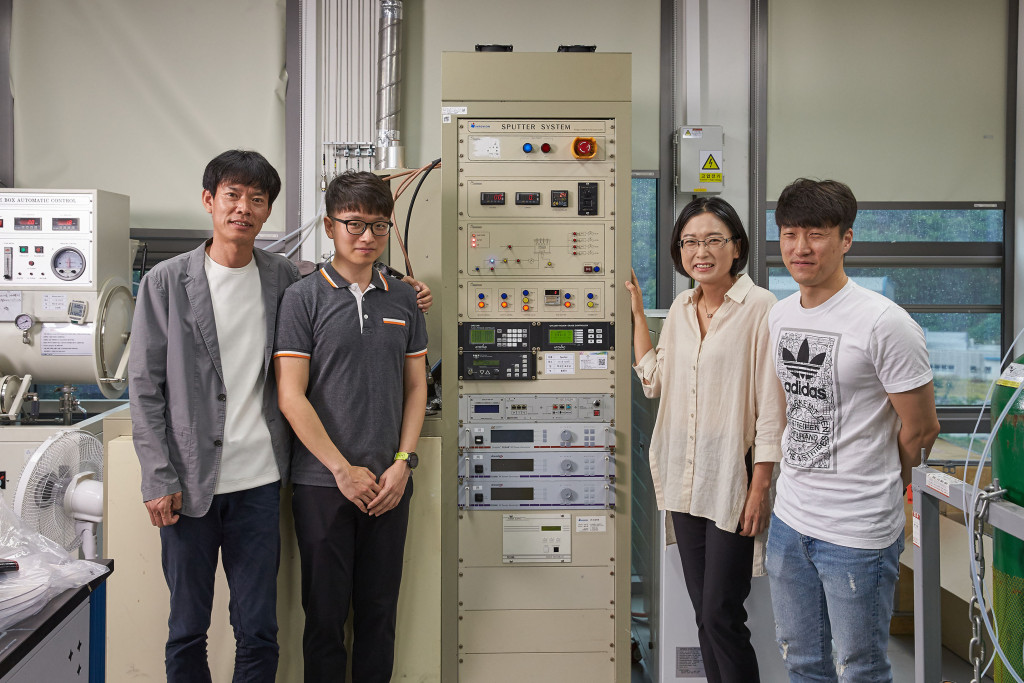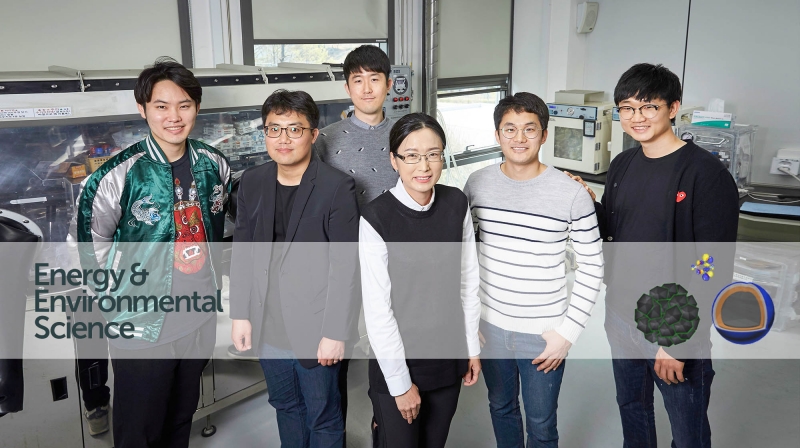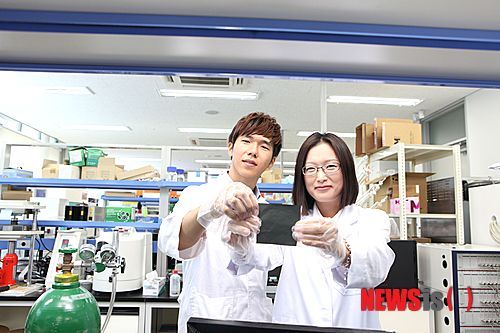News
* [Advanced Energy Materials] Prof. Nam-Soon Choi’s group reported highly stretchable separator membrane for energy storage devices.
A recent study, affiliated with UNIST has introduced a novel technique to develop a rubberlike stretchable battery. This is the first attempt to stretch the battery separator, positioned between the anode and the cathode.
This study has been jointly led by Professor Soojin Park, Professor Nam-Soon Choi, and their research teams in the School of Energy and Chemical Engineering at UNIST. The researchers have developed highly stretchable separator membranes for deformable energy devices.
The seperator, one of the critical components of a battery, is a porous insulating membrane, placed between the cathode and the anode. Its roles are to prevent their direct electrical contact and ensure sufficient ionic conductivity between the electrodes via the electrolyte present in the pores of the seperator.
Previous studies on stretchable batteries focused on the systematic deformation in electrode materials for Li-ion batteries. However, because these batteries use gel polymer electrolyte membrane or non-woven fabric types, manufacturing of such separators is a technically complicated and costly process. In coping with such issue, Professor Park and Professor Choi came up with a simple and inexpensive way to develop the separation membranes.
In the study, the team used styrene-butadiene-styrene (SBS) rubber for the preparation of highly stretchable separation membranes to ensure stretchability. Then, they used the non-solvent induced phase transition method (NIPS) to ensure neat, uniform holes. The new stretchable separator membrane operated normally when placed within the existing LIBs and exhibited a high stretchability of around 270% strain and porous structure having porosity of 61%.
In addition, SBS rubbers, due to their inherent properties, dissolve well in some solvents and not in others. If other solvents are mixed in a solvent that dissolves the SBS rubber, a porous structure is formed when the solvent evaporates. Solvents that do not melt well in the SBS rubber are trapped between them to form holes.
“Rubber materials interact with various solvents to create different porous structures,” says Myoungsoo Shin in the School of Energy and Chemical Engineering at UNIST, the first author of the study. “As a result, they have a porous structure that is well suited to battery separators and can maintain a stretchable stretch like rubber.”
“The phase transition method can be applied to various polymers, and it has been attempted for the first time to manufacture an elongated separator for a battery,” says Woo-Jin Song, another first author of the study. “By adjusting materials, solvents, phase transition conditions, etc., desired characteristics can be created.”
Researchers also applied the newly-developed rubber-like separators to the existing organic electrolyte based LIBs. As a result, the membrane functioned well even when it was normal and increased more than 2 times. In addition, the battery performance has been improved when applied to water-based electrolyte-based lithium ion batteries without explosive risks.
“This study proved that the new separator can be applied not only to organic electrolyte–based rechargeable lithium‐ion batteries, but also to aqueous electrolyte-based Li-ion systems,” says Professor Choi. “It will be also applicable for the battery systems that mainly use gel polymer electrolytes.”
“This is the first case we’ve applied the non-solvent induced phase transition method (NIPS) to develop stretchable separators for deformable energy devices,” says Professor Park, who led the research.
This study was supported by the Center for Advanced Soft Electronics (CASE) of Global Frontier Project, funded by the Ministry of Science and ICT. The findings of this work have been published in the prestigious journal, Advanced Energy Materials on June 21, 2018.
[울산종합일보]
http://www.ujnews.co.kr/news/articleView.html?idxno=416500
[전자신문]
* [Energy & Environmental Science] Prof. Nam-Soon Choi’s group reported an amphoteric electrolyte additive for high-energy-density lithium-ion batteries.
리튬이온배터리의 용량 한계를 뛰어넘을 기술이 나왔다. 에너지 밀도가 높은 실리콘계 음극 물질을 사용할 때 단점을 해결할 ‘전해액 첨가제(Electrolyte additive)’ 기술이다. 새 첨가제를 1% 더하면 기존보다 오래 쓰고, 한 번에 많은 힘을 내는 배터리가 된다.
최남순–홍성유 에너지 및 화학공학부 교수팀은 리튬이온배터리의 한계(고전압, 고용량)를 극복할 수 있는 ‘전해액 첨가제’ 기술을 개발했다. 이 결과는 ‘에너지 및 환경과학(Energy & Environmental Science, EES)’ 4월 6일자 온라인판에 발표됐으며, 중요성을 인정받아 표지논문(Back Cover)으로도 선정됐다.
리튬이온배터리의 에너지 용량을 높이기 위해 실리콘계 음극 물질(실리콘-탄소 복합체)를 사용하려는 시도가 많다. 이론적으로 실리콘의 에너지 밀도가 탄소보다 10배 크다고 알려졌기 때문이다. 하지만 실리콘 기반 음극 물질은 충전과 방전 과정에서 3배 이상 팽창해 상용화에 한계가 있다.
최남순-홍성유 교수팀은 실리콘계 음극 물질의 팽창을 제어하는 방법으로 새로운 전해액 첨가제(LiFMDFB)를 제안했다. 이 물질이 음극 물질을 견고하게 둘러싸서 실리콘이 팽창해도 구조적으로 안정성을 갖게 만든 것이다. 이와 더불어 양극에 고전압을 흘려도 망가지지 않도록 보호막을 만들게 했다.
이번 논문의 공동 제1저자인 한정구 UNIST 에너지공학과 석‧박사통합과정 연구원은 “전해액 첨가제가 전해액보다 먼저 분해돼 전극 표면에 보호하는 층을 만드는 원리”라며 “보통 전해액 첨가제는 양극과 음극에 따로 작용하는데, 새로 개발한 전해액 첨가제는 양극 보호는 물론 실리콘계 음극 제어에도 강력한 효과를 보였다”고 말했다.
일반적으로 고전압에 분해된 전해액은 주로 양극이나 음극 표면에서 화학적인 반응을 일으켜 전해액-전극 경계면(전극 계면)에서 불안정한 구조를 만든다. 최남순-홍성유 교수팀은 고전압에서 양극 계면을 보호하는 동시에 실리콘 음극의 부피 팽창을 제어하는 화합물을 만들기 위해 붕소(boron) 기반 전해액 첨가제를 설계하고 개발했다.
홍성유 교수는 “불소화된 말로네이트계 화합물을 통해 고리형 보레이트 구조를 구현해 전해액 첨가제를 만들었다”며 “이 물질은 설계할 때에 목표로 삼은 기능을 모두 달성해 향후 분자 설계를 통한 전해액 첨가제 개발 방향을 제시했다”고 전했다.
새로 개발한 전해액 첨가제(LiFMDFB)는 고전압에서 구동되는 ‘과리튬(Li-rich) 양극’은 물론, 고용량을 저장하는 ‘실리콘계 음극’을 보호하는 계면층을 각각 동시에 형성했다. 이 보호막 덕분에 4.55V의 높은 충전 전압에서 200회 반복 충‧방전 실시에도 양극과 음극의 구조적인 안정성이 유지되고, 12분 만에 전체 배터리 용량을 모두 쓰는 고출력 조건(5C)에서도 높은 용량 구현율을 보여줬다.
최남순 교수는 “전체 배터리에서 1% 정도 차지하는 전해액 첨가제만으로 고전압 양극과 고용량 음극의 구현이 가능해 전체 리튬이온배터리의 성능을 높일 수 있다”며 “이번 연구로 고전압 양극과 고용량 음극의 계면구조에 대한 전해액 첨가제의 근본적인 역할에 대한 이해도 가능해졌다”고 연구의 의미를 짚었다.
최 교수는 이어 “향후 고전압 양극 소재 개발과 고에너지 밀도를 갖는 리튬이온 배터리의 상용화에도 기여할 것”이라고 전망했다.
이번 연구에서 전해액 시스템 개발과 메커니즘 규명은 최남순 교수와 한정구 연구원이 담당했다. 홍성유 교수와 이재빈 UNIST 화학공학과 석‧박사통합과정 연구원은 분자 설계를 통해 이차전지용 전해액 첨가제를 간결하게 많이 얻는 합성법을 개발했다. UNIST 에너지 및 화학공학부의 조재필 교수와 강석주 교수, 곽상규 교수도 공동으로 참여했다.
연구 수행은 산업통상자원부와 울산광역시청이 지원하는 ‘그린에너지 소재기술 개발센터 구축사업’의 지원으로 이뤄졌다.
[경상일보]
http://www.ksilbo.co.kr/news/articleView.html?idxno=635916#08fn
* [Angewandte Chemie International Edition] Prof. Nam-Soon Choi’s group reported new polymeric binder for high-performance Si negative electrode in Li-ion batteries
대학 학부생이 주도한 리튬이차전지 실리콘 음극소재의 성능을 개선한 신기술 연구 논문이 세계적인 화학저널에 게재돼 화제다.
UNIST(울산과학기술대학교·총장 조무제)는 친환경에너지공학부 4학년 구본재(23)씨가 최남순 교수의 지도로 리튬이차전지 실리콘 음극소재의 성능을 개선한 연구 ‘리튬이차전지용 고성능 실리콘 음극실현을 위한 형성기억형 그물구조 고분자’ 결과를 지난 29일 세계적인 화학 저널인 앙게반테 케미(Angewandte Chemie)에 발표했다고 30일 밝혔다.
구씨는 3차원 그물구조의 형상기억형 고분자를 이용해 현재 상용화된 탄소계 음극소재 대비 전기화학적 성능이 뛰어나고 충전용량도 5배 정도 큰 실리콘 음극소재 성능을 개선하는 기술을 개발함으로써 고용량 실리콘 음극판 형성에 응용 가능성을 열었다.
리튬이차전지는 현재 휴대폰, 노트북 컴퓨터 등 휴대통신기기에 폭넓게 사용되고 있고, 최근에는 하이브리드 전기자동차와 지능형 로봇 등의 동력원뿐만 아니라 태양광, 풍력 발전 등 신재생 에너지용 전력저장 중대형 전지시스템으로 주목받고 있다.
그러나 현재 상용화된 탄소계 음극은 한계용량(372mAh/g)이 낮아 에너지 밀도를 높이는 것이 이슈로 제기되어 왔다. 최근에는 용량 개선을 위해 탄소계 음극보다 약 10배 높은 이론용량(4200mAh/g)을 가진 실리콘 음극소재가 대체재로 떠오르고 있다.
실리콘 음극은 리튬과의 화학적 결합형성으로 전기화학적 충전 반응 동안 400%의 심각한 부피팽창이 일어난다. 이 때문에 전기적 연결이 방해를 받게 돼 반복적인 충방전 싸이클 동안 리튬을 저장하는 능력이 급격하게 저하되는 문제가 있다.
구씨는 3차원 그물구조의 형상기억형 고강도 고분자를 실리콘 음극입자와 물리적․화학적으로 강하게 결합해 부피팽창을 효과적으로 억제하여 실리콘 음극의 전기화학적 성능 및 충전용량을 획기적으로 향상하는데 성공했다.
이번 연구의 부피팽창을 효과적으로 개선한 결과는 배터리 안정성을 높이는데 기여할 것으로 예상한다.
최남순 교수는 “이번 연구에서 개발된 인공 고분자는 많은 전기에너지를 저장할 수 있는 실리콘 음극소재의 상용화를 앞당길 수 있는 중대한 소재기술이라는 점에서 의의가 있다”고 말했다.
구본재씨는 “연구 분야에 대한 이론 이해, 실험의 목적, 결과 분석뿐만 아니라 진로에 대한 많은 것을 지도해주신 최남순 교수님께 감사한다”며 “앞으로 UNIST 대학원에 진학해 실리콘 음극의 부피팽창 문제 해결과 이차전지 전해질 분야에 대해 연구할 것”이라고 밝혔다.
[뉴시스]




